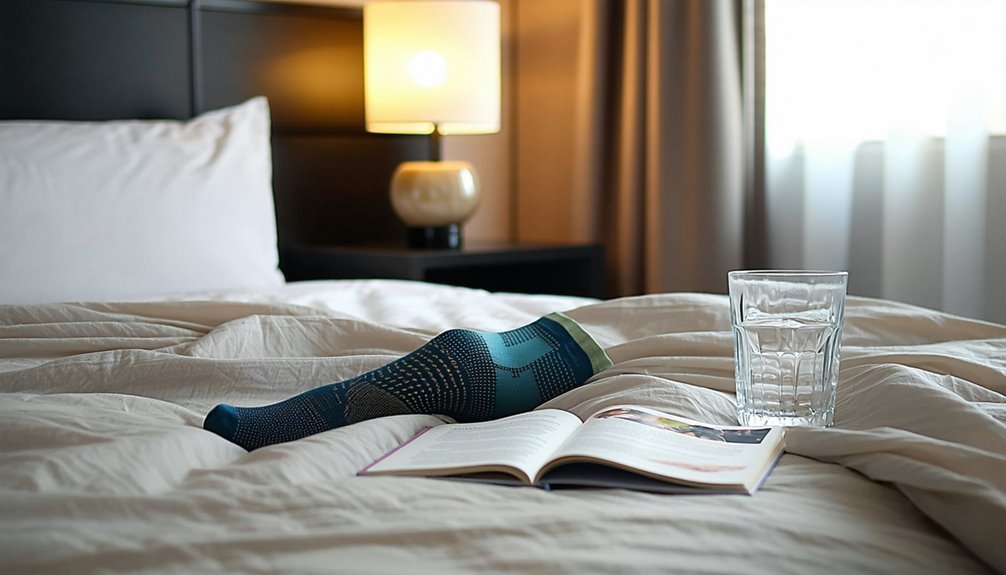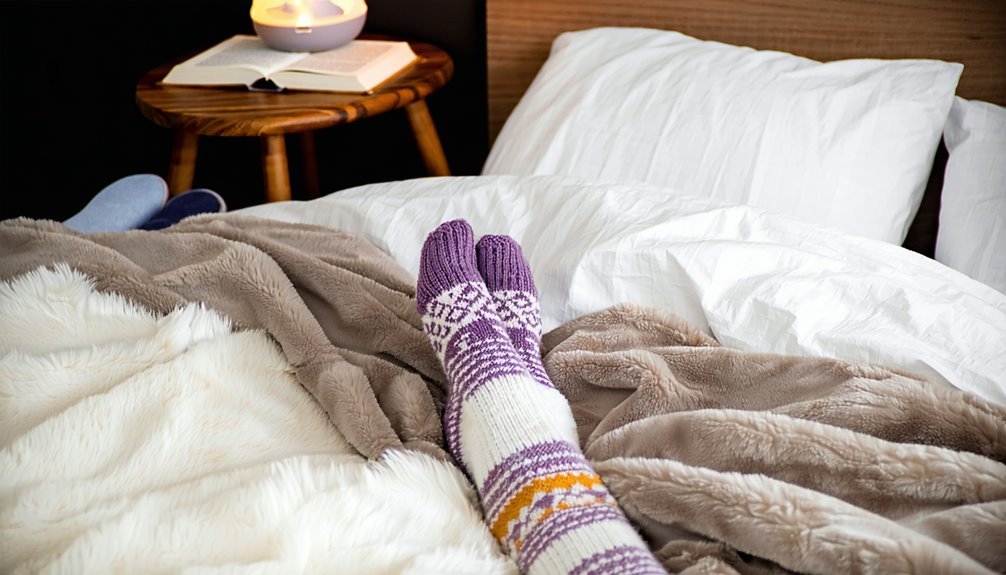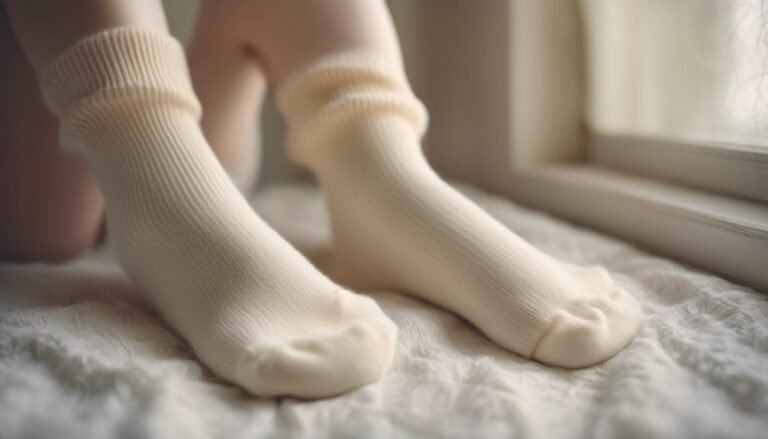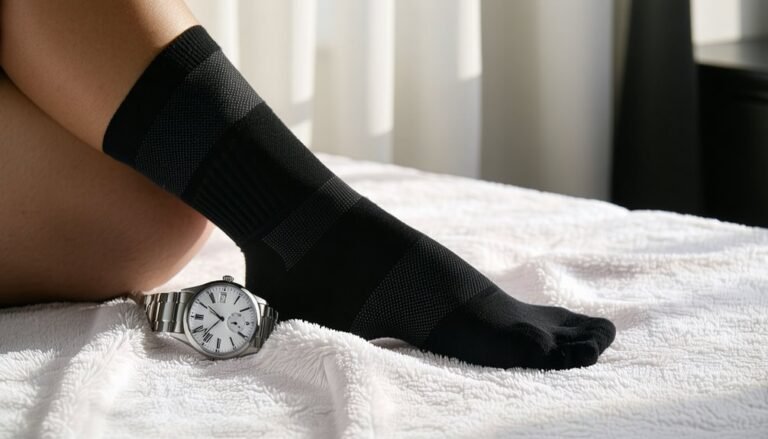Can You Wear Compression Socks Overnight?
Wearing compression socks overnight can be beneficial by improving circulation and reducing swelling, especially for those prone to edema or discomfort from varicose veins. However, make certain they fit well to avoid restricted blood flow and potential skin irritation. Consider factors like personal health conditions and comfort level, and consult a healthcare professional for advice tailored to your needs. Explore further for guidance on safe and effective compression sock use.
Understanding the Purpose of Compression Socks

While many people consider compression socks a mere accessory, their primary purpose is rooted in medical science and evidence-based health benefits. You'll find that these socks come in various compression sock types, each designed to meet specific needs. Graduated compression socks, for example, are tighter at the ankle and gradually loosen up the leg, promoting ideal blood flow. Another type, anti-embolism stockings, are typically used post-surgery to prevent deep vein thrombosis.
The compression sock benefits are numerous. They can help reduce swelling, alleviate discomfort from varicose veins, and improve circulation, which is essential for those at risk of blood clots. By selecting the right type, you're ensuring safety and enhancing your vascular health. Understanding these benefits can greatly impact your overall well-being.
How Compression Socks Work
Building on the understanding of their purpose, compression socks operate through a straightforward yet effective mechanism. They utilize a compression mechanism to apply a precise pressure gradient along your leg. This means the pressure is highest at the ankle and gradually decreases as it moves up the leg. This gradient aids in:
Compression socks apply a pressure gradient along your leg, highest at the ankle, decreasing upwards.
- Enhancing blood circulation, ensuring oxygen and nutrients reach your muscles efficiently.
- Reducing swelling by promoting the return of fluid to the body's central circulation.
- Preventing deep vein thrombosis, a serious condition that could occur when blood pools in your veins.
- Alleviating discomfort associated with prolonged standing or sitting.
These benefits are backed by clinical evidence, making compression socks a safe and effective choice for many seeking better leg health.
Medical Conditions That Benefit From Compression
Although compression socks are often associated with athletes and travelers, they offer significant benefits for various medical conditions. For individuals with venous insufficiency, these socks provide essential support by promoting blood flow back to the heart, reducing swelling, and minimizing the risk of clot formation. Compression socks apply graduated pressure, which is critical in preventing blood from pooling in the lower extremities, therefore alleviating symptoms like leg pain and heaviness.
In the context of lymphedema management, compression socks aid in reducing fluid buildup by facilitating lymphatic drainage. This function is fundamental in managing swelling and discomfort in affected limbs. By wearing compression socks, you can enhance your quality of life, ensuring safer and more effective management of these conditions under medical guidance.
Expert Opinions on Wearing Compression Socks Overnight

When considering whether to wear compression socks overnight, it's essential to understand the perspectives of medical experts. They emphasize that while compression socks can promote blood circulation, their overnight use should be approached with caution. Expert recommendations highlight that overnight guidelines depend on individual health conditions. Here are key expert insights:
Consult healthcare experts: Overnight compression sock use depends on individual health conditions and should be approached cautiously.
- Consult a healthcare provider: Determining if overnight use is safe for you is important.
- Assess medical conditions: Conditions such as diabetes or peripheral artery disease may require special consideration.
- Monitor comfort levels: Discomfort or skin changes may indicate improper use.
- Follow prescribed compression levels: Verify socks match medical advice to avoid adverse effects.
Potential Risks of Overnight Use
When wearing compression socks overnight, you should be aware of potential skin irritation, as prolonged contact can lead to moisture retention and friction-related issues. Evidence suggests that improperly fitted socks might restrict circulation, which could exacerbate existing vascular conditions. It's essential to monitor any discomfort and consult healthcare professionals to guarantee safe use.
Skin Irritation Concerns
While compression socks are often recommended for enhancing circulation, their overnight use may pose skin irritation risks. Different skin types react variably to prolonged compression. To minimize irritation, consider these preventive measures:
- Choose the Right Material: Opt for socks made from breathable, moisture-wicking fabrics to reduce sweat and friction.
- Proper Fit: Verify socks aren't too tight, as inadequate sizing can exacerbate skin irritation.
- Skin Care Routine: Regularly moisturize your skin to maintain its barrier function and prevent dryness.
- Time Limits: Limit wear to shorter periods initially to assess your skin's tolerance.
These steps can aid in irritation prevention, but if you notice persistent redness or itching, it might be best to discontinue overnight use and consult a healthcare professional for guidance.
Circulation Restriction Issues
Despite the benefits of compression socks for circulation, overnight use may inadvertently lead to circulation restriction, posing significant risks. When worn too tightly or for extended periods, these socks can compromise circulation health. This might impede proper blood flow, particularly during sleep when your body's natural circulation processes are already slowed. Vein function can be adversely affected, potentially exacerbating issues like chronic venous insufficiency. Compression that's too high can create pressure points, leading to discomfort or, worse, tissue damage. If you experience tingling, numbness, or increased swelling, it's essential to reassess the fit and duration of wear. Always consult a healthcare professional to ascertain your compression socks are appropriate for overnight use, safeguarding your vein function and overall circulation health.
User Experiences and Testimonials
Many users have reported positive experiences with wearing compression socks overnight, citing noticeable improvements in leg comfort and reduced swelling. Personal stories often highlight how these garments help alleviate discomfort related to prolonged standing or sitting. From user experiences, several benefits are frequently mentioned:
Users report improved leg comfort and reduced swelling from wearing compression socks overnight.
- Enhanced Circulation: Some users note improved blood flow, reducing the chance of waking up with restless legs.
- Swelling Reduction: Many find a significant decrease in morning swelling, especially those prone to edema.
- Pain Alleviation: Users with chronic leg pain report less discomfort and a more restful sleep.
- Increased Comfort: Testimonials often emphasize the cozy, secure feeling provided by compression socks.
These insights offer valuable perspectives for anyone considering wearing compression socks overnight, ensuring a balance of comfort and safety.
Factors to Consider Before Wearing Them to Bed
Before wearing compression socks to bed, it's essential to take into account your specific health conditions, as these socks can affect circulation and exacerbate certain issues like peripheral neuropathy or diabetes. Ensuring a proper fit is equally important, as improperly fitted socks might cause discomfort or constrict blood flow, negating any potential benefits. Finally, while compression socks can aid in reducing leg swelling, their overnight effectiveness is limited and not universally beneficial, warranting a consultation with a healthcare professional for personalized advice.
Health Conditions Matter
When considering wearing compression socks overnight, it's important to evaluate specific health conditions that may be impacted by their use. For those with venous insufficiency, compression socks can support improved blood flow, potentially reducing symptoms. However, if you're managing edema, it's vital to verify the socks aren't constricting, as improper use can exacerbate swelling. Before using them, consult a healthcare professional to address potential concerns. Consider these conditions:
- Peripheral artery disease: Reduced blood flow might worsen with compression.
- Diabetes: Neuropathy risks require careful assessment.
- Congestive heart failure: Fluid accumulation needs professional guidance.
- Skin conditions: Sensitive skin may react adversely to prolonged wear.
Safeguarding your health by understanding these conditions guarantees effective and safe compression sock use.
Proper Fit Importance
Achieving the right fit in compression socks is essential for maximizing their benefits and minimizing potential risks, especially when worn overnight. Proper measurement techniques are vital. Begin by measuring the circumference of the ankle, calf, and sometimes thigh; these dimensions guide the selection of the appropriate compression level and sock size. A poor fit can lead to discomfort and restricted circulation, counteracting the intended therapeutic effects. Comfort level considerations are equally important. The socks should feel snug but not overly tight. If they cause numbness or pain, they may not be suitable for overnight wear. Always consult with a healthcare professional if unsure about the fit, ensuring that your compression socks provide support without compromising safety.
Overnight Benefits Limitations
Although compression socks can offer therapeutic benefits, it's important to weigh their limitations before deciding to wear them overnight. While they might provide overnight comfort by enhancing circulation, there are factors you should consider to guarantee your sleep quality isn't compromised.
- Skin Irritation: Extended wear may cause itchiness or irritation, particularly if the socks are too tight.
- Restricted Blood Flow: If compression levels are too high, they might impede circulation rather than improve it.
- Discomfort: Not all individuals find the sensation of compression comfortable during sleep, potentially disturbing rest.
- Medical Conditions: Existing health issues, like peripheral neuropathy, may be exacerbated by overnight use.
Evaluating these factors is vital in determining if wearing compression socks overnight aligns with your personal health needs and safety.
Alternatives to Overnight Compression Socks

Compression socks are a popular choice for managing various circulatory issues, yet exploring alternatives can provide comparable benefits, especially for overnight use. Alternative therapies like elevation and gentle massage can enhance circulation without the need for compression. Elevating your legs above heart level, for instance, helps reduce swelling by promoting venous return. Incorporating lifestyle changes, such as regular physical activity and maintaining a healthy weight, can also improve circulation over time. You might consider engaging in exercises like walking or cycling, which enhance cardiovascular health and naturally boost blood flow. Additionally, hydration plays a critical role, as proper fluid intake keeps blood from becoming too viscous. By incorporating these methods, you can achieve effective results safely, without relying solely on compression socks.
Tips for Choosing the Right Compression Socks
When selecting the right compression socks, how do you guarantee you're making the best choice for your needs? Prioritize safety and effectiveness by considering these key factors:
- Compression Level: Choose the appropriate level of compression (measured in mmHg) based on your medical needs or physician's advice.
- Compression Sock Materials: Opt for breathable, moisture-wicking fabrics like nylon or spandex to prevent skin irritation and facilitate comfort.
- Compression Sock Styles: Consider styles that fit your lifestyle, such as knee-highs for everyday use or thigh-highs for additional support.
- Fit and Size: Confirm socks fit snugly without being too tight. Measure your ankle and calf circumference to find the right size.
Selecting thoughtfully will enhance circulation, reduce swelling, and provide the comfort you deserve.
Frequently Asked Questions
How Often Should Compression Socks Be Replaced?
You should replace compression socks every 3-6 months, depending on the compression socks lifespan. Look for signs replacement needed, such as loss of elasticity, visible wear, or decreased effectiveness to guarantee continued safety and support.
Can Children Wear Compression Socks Overnight?
Did you know 30% of children's health issues stem from circulation problems? Guaranteeing sock comfort is critical. While some children can wear compression socks overnight, always consult a pediatrician to guarantee safety and proper fit.
Are There Any Eco-Friendly Compression Sock Options?
You're considering eco-friendly compression socks, and it's wise to look for ones made from sustainable materials like organic cotton or bamboo. Some brands offer biodegradable options, ensuring reduced environmental impact while maintaining therapeutic benefits and safety.
How Do Compression Socks Affect Skin Health?
Imagine your skin as a guarded fortress. Compression socks, your trusty sentinels, boost blood circulation but can sometimes cause skin irritation. Ascertain they're properly fitted and removed periodically to keep your skin's defenses robust and healthy.
Can I Wear Compression Socks During Pregnancy?
During pregnancy, wearing compression socks can offer benefits like reduced swelling and improved circulation. It's safe if you choose the correct size and compression level. Consult your healthcare provider to guarantee sock safety tailored to your needs.







